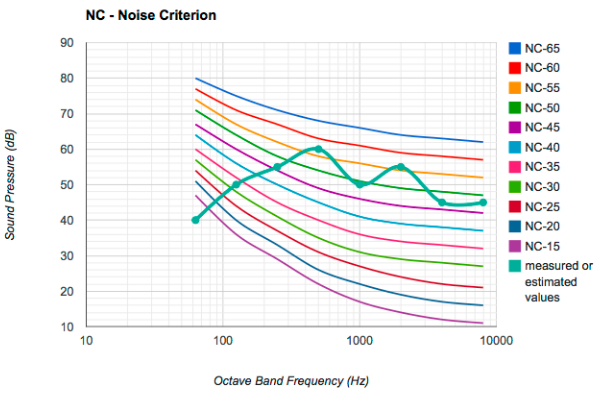News
NOISE CRITERION LEVEL
The Noise Criterion (NC) level is the one of the noise evaluation, which was established in U.S and indexes for the noisiness or quietness of an indoor room. NC used in the measurement of noise from mechanical sources such as air conditioning systems in environments such hotels, cinemas and schools.
A set of NC criterion curves drawn on graph is used to find the NC level. At first we measure the sound pressure level of each octave band of the noise spectrum and them plot every octave band level on the graph. The NC level is the label attached to the lowest curve which is not exceeded by the spectrum.

The NC level is used to help set design goals that will ensure a maximum acceptable indoor noise, dependent on the purpose of the room. International standards organizations (ISO, ANSI and ASA) recognize the need to objectify judgements on the amount of ambient noise in enclosed spaces, and provide us with definitions for various Noise Curves. The ANSI/ASA S12.2-2008 standard, for example, NC-40 is the limit that workers can endure in the office, while noise lower than NC-25 is desirable in the concert hall.
The standard ANSI/ASA S12.2-2008 recommends the following criterias:
|
Type of Room |
NC |
|
Concert halls, opera houses |
15-18 |
|
TV and broadcast studios |
15-25 |
|
Schools |
25-35 |
|
Offices |
25-40 |
|
Conference rooms |
25-35 |
|
Private rooms of Hospitals |
25-30 |
|
Movie theatres |
30-40 |
|
Libraries |
30-35 |
|
Restaurants |
40-45 |
|
Shops and garages |
50-60 |
Due to International standards and recommendation of WHO, the Government of Vietnam has made great strides in awareness of the noise impact on human health. Therefore, a system of National Standards for Noise and Noise Level in Vietnam has been issued:
- TCVN 5964-1995: Acoustics: Description and measurement of environmental noise.
- TCVN 5949: Acoustics - Noise in public and residental areas Maximum permited noise level.
- TCVN 3985-1999: Acoustics – Allowable noise level at workplace.
- TCVN 5948-1999: Acoustic - Noise emitted by accelerating road vehicles - Permitted maximum noise level.
- TCVN 7878-1:2008: Acoustics – Desription, measurement and assessment of environmental noise.
- TCVN 8018:2008: Acoustics - Noise control design procedures for open plant.
- QCVN 26:2010/BTNMT: National Technical Regulation on Noise.
Source: TECOTEC HCM
Others
- TECOTEC GROUP ATTENDED SHIMADZU’S SERVICE MANAGER MEETING IN 2022
- TECOTEC HANDED OVER EDX-7000 X-RAY FLOURESCENCE SPECTROMETER AT NIDEC CHAUN CHOUNG VIETNAM
- INSTALLATION OF CHIP PROCESSING SYSTEM – LANNER/ GERMANY
- TECOTEC completed installation of EDX-LE Energy dispersive X-ray Fluorescence spectrometer at DYT Vina
- TECOTEC DELIVERED AND INSTALLED THE 2ND X-RAY FLUORESCENCE SPECTROMETER - EDX-LE PLUS AT TABUCHI
- TECOTEC Group has handed over PDA-7000 Optical Emissions Spectrometers for Nihon Plast Vietnam
- Bowman XRF Coating Measurement System For Electroless Nickel Plating
- TECOTEC DELIVERED AND INSTALLED SMX-2000 SYSTEM TO NIDEC TECHNO MOTOR VIETNAM



